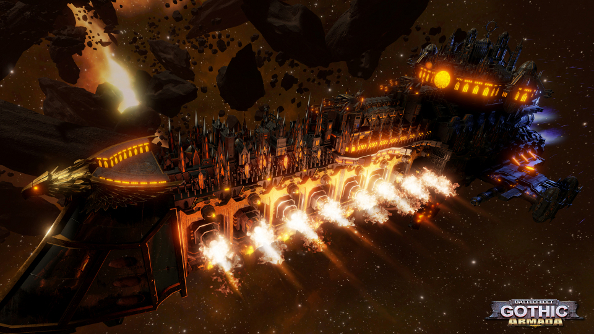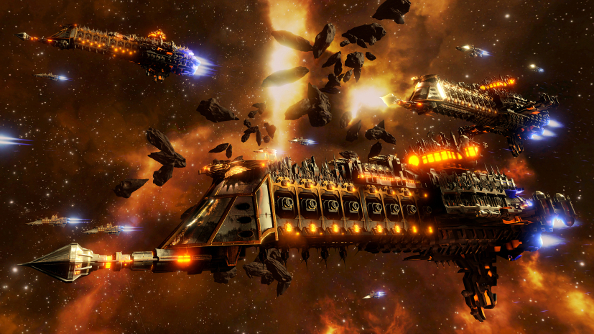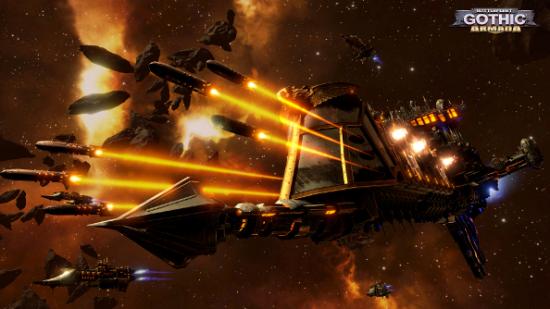Games Workshop’s licensing policy has been like the fire of a skaven cannon lately: unpredictable and prone to backfires. But developers are increasingly finding a middle ground between the tabletop slavishness of Space Hulk and full-scale reworks like Dawn of War (as Relic now admit, space marines don’t take cover).
Joining the terribly promising Mordheim: City of the Damned is Battlefleet Gothic: Armada – a real-time translation of Warhammer’s big-boats-in-space wargame. Built in Unreal Engine 4, Armada’s ships are as behaviourally complex as they are beautiful.
Parisian indies Tindalos began work on Armada at Games Workshop’s behest. The studio’s last large-scale strategy game was last year’s Etherium, but it was 2012’s Stellar Impact that reminded the tabletop publishers of their own work.
“They were interested,” said Tindalos’ Roman Clavier. “They thought that Stellar Impact was very similar and that we were the best translators for Battlefleet Gothic.”
Tindalos have “of course” played the tabletop game, and own “all the armies”. But once they had the license, they made the “tough choice” to leave Battlefleet’s turn-based roots behind.
“There are very good turn-based games made with the Games Workshop license that use only the rules of the board game,” explained Clavier. “Blood Bowl is a nice example.
“But we thought about it for a bit longer, and the conclusion was that when you play Blood Bowl, you have many animated characters – there is life in the stadium, even when it’s not your turn.”
Battlefleet Gothic players, by contrast, move and fire just one ship per turn. As a digital proposition, it’s a far cry from the expectations of those brought up with the busy space scuffles of Star Wars.

The real-time compromise Tindalos have prototyped has “everything moving at the same time”, yet retains the thoughtful pace of its inspiration – a “transposition of naval battles into space”. The player will be launching torpedoes, firing broadsides and leading boarding parties.
As an admiral, they’ll also take charge of the fleet at their back – directing ships in tactical manoeuvres while leaving the details to the AI. Tindalos will allow players to preset the behaviour of each vessel before battle; think Dragon Age, but with each companion replaced by a miles-long frigate.
This autonomous ship behaviour is the thing Tindalos are most proud of in their four-month-old “prototype of a prototype”.
“We have invested quite a lot of R&D in this aspect of the game and the least we can say is that it was worth it,” said Clavier. “Witnessing huge fleets moving in formation and engage the enemy in an epic space ballet, or skillfully ram or avoid space cruisers that are several kilometres tall, is quite satisfying.”
By default, the ships will strike a balance between offensive and defensive fighting while shooting for the objective of the mission. But players can tell them to stay in boarding range, for instance, or to take every possible opportunity to ram enemy vessels.
“What is really important with this behavioural system is that the player can invest the concentration they want in the game,” said Clavier. “If you are a fan of StarCraft II, well, you can micromanage all your ships. But if the idea of space battle appeals to you, you can simply set all of your behaviour before the battle, click start, and manage only your admiral ship.”
Battlefleet Gothic: Armada is penciled in for a PC release before Christmas. Unreal Engine 4 development is available to anyone for a $19 monthly subscription fee.
In this sponsored series, we’re looking at how game developers are taking advantage of Unreal Engine 4 to create a new generation of PC games. With thanks to Epic Games and Tindalos Interactive.
The complex AI has been made possible by Unreal Engine 4. The engine’s simplified programming system, Blueprint, has saved Tindalos’ team of 15 an “enormous amount of time” – letting them prototype mechanics quickly and implement custom movement physics.
“As technical as the engine can be, it is still very user-friendly, and that is the best compromise for us,” said Clavier. “Although UE4 is new to many members of our team, the engine’s potential and the results we have achieved after only a few weeks has reassured us that we have chosen the right engine to give Battlefleet Gothic fans a game worthy of their expectations.”
Battlefleet’s zoomed-out view of the 40K universe boasts a very distinctive look. Games Workshop have lent Tindalos all of the universe’s space combat reference material to help them get it right – and though the studio are still “scratching the surface” of the game’s lighting, early screenshots bear the familiar gold hue of the original game’s box art.
In the vacuum, the cold spiritualism of the Imperium manifests as something like medieval architecture. Countless turrets jut like buttresses from the ships, which Tindalos have recreated at a granular level.
“Above all, UE4 has allowed us to achieve an impressive level of detail,” said Clavier, “which comes in handy when you are dealing with five-kilometer-tall space cathedrals.”

The detail isn’t only aesthetic, but crucial in tracking the course of a battle. Every system on a ship can be targeted individually – including the bridge that houses its captain, or the warp drive that enables a player to disengage a damaged vessel, saving precious upgrades and crew experience.
“Like in the board game, you can take critical damage,” said Clavier. “You can lose your weapon, you can lose your reactor, the generator, the bridge – and all of this is permanent.”
When a part takes critical damage, the player will see it consumed by fire or smoke – knowing that even if they manage to pull the ship through to the end of the battle, they’ll need to pay for repairs on a five-kilometre scale.
There’s going to be plenty else intriguing in Battlefleet Gothic: Armada: the optional execution of wayward officers; the dynamic campaign structure inspired by Dawn of War II; the XCOM-like loss of regions and bonuses to the Chaos, Orks and Eldar fleets flooding the map. But Tindalos are most concerned with the space battles they’re already building in-engine.
“There are lots of things I love in a fight in Battlefleet Gothic, but I guess it’s about overwhelming your opponent with tactics, placement, using the environments as well as you can,” said Clavier. “We really want to get the flavour of the original board game.”
Battlefleet Gothic: Armada is penciled in for a PC release before Christmas. Unreal Engine 4 development is available to anyone for a $19 monthly subscription fee.
In this sponsored series, we’re looking at how game developers are taking advantage of Unreal Engine 4 to create a new generation of PC games. With thanks to Epic Games and Tindalos Interactive.
